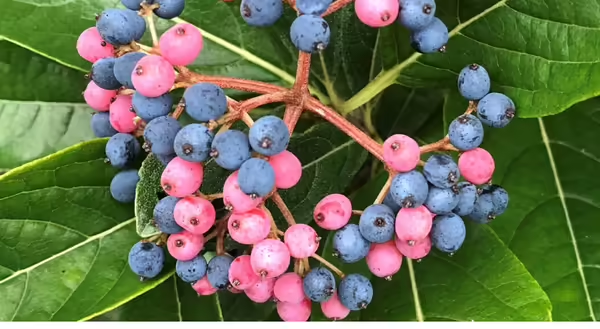
Have you ever heard a horticulturists encourage the use of plants having “multiple seasons of interest”? This might be said in response to someone’s complaints about forsythia, for example.
Forsythia blooms in spring, an explosion of lemon-yellow blossoms covering the plant. But the rest of the year, it is drab and unruly. The unruliness causes many gardeners to shear the shrub into boxes (completely unnecessarily) and then when spring comes again the flower display is subpar and sparse—one season of interest is all you will get from forsythia.
This fall, there are some plants that should be celebrated for their multiple seasons of interest. Not only do these plants have good flower displays and pretty foliage, they have a remarkable presentation of fruits called drupes. A drupe is a fleshy fruit where the inner ovary walls are hard, whereas a berry has soft ovary walls. An example of a drupe is cherry and an example of a berry is, believe it or not, a tomato.
‘Brandywine’ possumhaw viburnum (Viburnum nudum) has an outstanding presentation of pink and blue berries in fall. These ‘Brandywine’ drupes are preceded by fragrant white flowers that appears in early summer. As these drupes ripen, they continue to intensify in color, peaking with a red-to-maroon display late in the fall. This shrub grows 5-6 feet tall and will have a more impressive fruit display if planted in a group. These drupes are acidic, but edible.
Beautyberry (Callicarpa Americana) has become a standout for the native fall garden with its crisp vivid purple-magenta berries that populate the entire stem on these three- to six-foot shrubs. They follow small light pink flowers in the late summer. The fruit display is more impressive in full sun but this plant can grow in part shade, even under coniferous trees. Fruits remain on the plant well into the winter, months after the foliage has created a nice backdrop of yellow fall color. These bright purple fruits are eaten by birds. Berries are not poisonous for humans, but are bitter.
White fringe tree (Chionanthus virginicus) has dark blue drupe with a bloomy (white powder) appearance. They hang like bobble earrings on ten to twenty foot multi-stemmed shrubs, and are savored by the birds once they ripen but are inedible to humans. Flowers are fragrant and quite showy in early June, but are short lived, about two weeks. White fringe tree is dioecious, so a male and female plant must be present to produce berries. Many plants sold in stores have an opposite-sex branch grafted on. The tree sometimes has what are known as ‘perfect flowers,’ where both female and male parts exist on one flower. Fall color can be an impressive yellow, but it’s variable. White fringe is native to south eastern part of the United States.